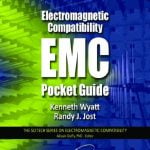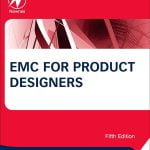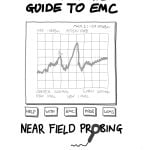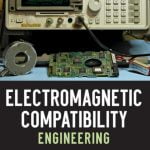If I were to advise someone just starting in the field of EMC today, the advice I would give them would depend on what field they wanted to go into and their background.
I didn’t plan to go into EMC testing or Engineering. I started at CASS Industries in 2014 without any experience or knowledge of EMC, other than knowing it stood for Electromagnetic Compatability. Since CASS which is what is known as “Commercial EMC” I have moved into Automotive EMC. Whilst I don’t have direct experience in the aerospace or military sectors. The skills are transferable enough to learn from fundamentals.
So let’s quickly have a quick list of advice:
Read some books on EMC
There are several books on EMC Engineering that I recommend reading, the first is Kenneth Wyatt & Randy Jost’s EMC pocket guide, Tim Williams’ EMC for Product Designers, and James Pawson of Unit 3 Compliance has several free resources (James also teaches training courses). At some point in the future, I will write more detailed book reviews covering the books in more detail.
Electromagnetic Compatibility EMC Pocket Guide – Kenneth Wyatt & Randy Jost
This is a very short book that contains a quick reference to most of what an EMC Technician or Engineer would need to explain to a customer when they come to the EMC lab with a DUT (Device under test).
This book is available from Amazon and is listed as “Addressing the most common reasons for compliance failure and key EMC issues faced within industry, this handy and concise pocket guide is ideal for electronic and system designers, students, lecturers and researchers in electrical engineering.”
The Pocket guide also contains commonly used equations such as the “Ohms Law Formula wheel“
EMC for Product Designers – Tim Williams
Tim Williams’ book is a very good introduction to EMC, it assumes some technical knowledge on the subject of Electrical and Electronic Engineering from the reader, and an understanding of how to read technical documentation.
The first half of the book contains a detailed background of EMC testing, reasons for aiming for compliance, and all the required tests and paperwork for placing a product on the market.
The book’s Second half is aimed at PCB and enclosure layout, specifically for Product designers. Even if this is not your position, it will give you a good understanding of things to look out for in design reviews.
This book is available from Elsevier or Amazon, while it is not a cheap book, it is worth the cover price for the information contained inside it.
At some point in the future, I will write a more detailed book review for Tim Williams’ EMC for Product Designers.
The Graphical Guide to EMC – Near Feild Probing – James Pawson
This free PDF is available for download via the Unit 3 site.
This book is about near-field probing and covers a topic we will cover below in this post.
If you catch up with James at a trade show, chances are you will have one of his Unit 3 Compliance Pocket EMC Debug Probe sets, If you don’t you can either make your own or buy a set from Tekbox.
I think I have two sets of James’ pocket EMC Debug Probe Sets on my desk at home.
James hasn’t at the time of writing this post written any more “Graphical Guide to EMC” publications. However, when he does I can pre-emptivly recommend them.
Electromagnetic Compatability Engineering – Henry W. Ott
This is a bonus book on this list, it goes far beyond what you need to know for working in an EMC lab or giving advice to customers about how to fix their products.
Like EMC for Product Designers above, EMC Engineering by Henry Ott is considered to be a seminal resource for EMC engineering. but again like Tim Williams’ book EMC Engineering is fairly expensive. You can buy it from Amazon.
This book is not one to read cover to cover when you just start out, it’s much more useful as a reference to aid in diagnostic issues with specific issues as they arise, and to expand your knowledge while performing tests in the EMC Test Lab.
Subscribe to Free Magazines
- In Compliance Magazine – incompliancemag.com
- Interference Technology – interferencetechnology.com
Read relevant standards.
Regardless of the field you are looking at, I would start with gaining an understanding of the commercial generics, and understanding how to perform emissions and immunity testing in either a TEM cell or a SAC.
The pocket guide to EMC by Kenneth Wyatt & Randy Jost lists the common Basic EMC Standards, At some point over the next few posts I will write about some of these. (Probably starting with ESD).
| Type | Standard | Test / Scope |
|---|---|---|
| Commercial | CISPR 11 | ISM Equipment |
| CISPR 22 | ITE Equipment | |
| CISPR 16 | Methods of Measurement | |
| IEC 61000-3-2 | Harmonics | |
| IEC 61000-3-3 | Flicker | |
| IEC 61000-4-2 | Electrostatic Discharge (ESD) | |
| IEC 61000-4-3 | Radiated Immunity | |
| IEC 61000-4-4 | Electrically Fast Transient (EFT) | |
| IEC 61000-4-5 | Surge (Lightning) | |
| IEC 61000-4-6 | Conducted Immunity | |
| IEC 61000-4-8 | Magnetic Immunity | |
| IEC 61000-4-11 | Dips, Interrupts, Voltage Variations | |
| FCC Part 15B | ITE Equipment | |
| ANSI C63.4 | Methods of Measurement | |
| Medical | IEC 60601-1-2 | Medical Products |
| Automotive | SAE J1113 | Automotive EMC |
| Military | MIL STD 461F | EMC Test Requirements |
| Aerospace | DO-160 | EMC Test Requirements (Aircraft) |
| SAE ARP5412B | Aircraft Lightning Environment & Related Test Waveforms | |
| SAE ARP5416A | Aircraft Lightning Test Methods |
This post is getting a bit long now… so I will break the rest of it into a second post at a later date.








